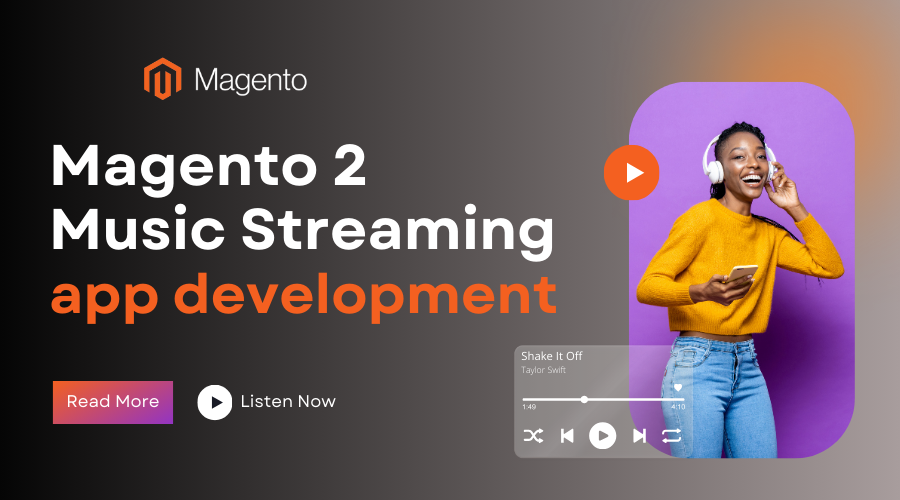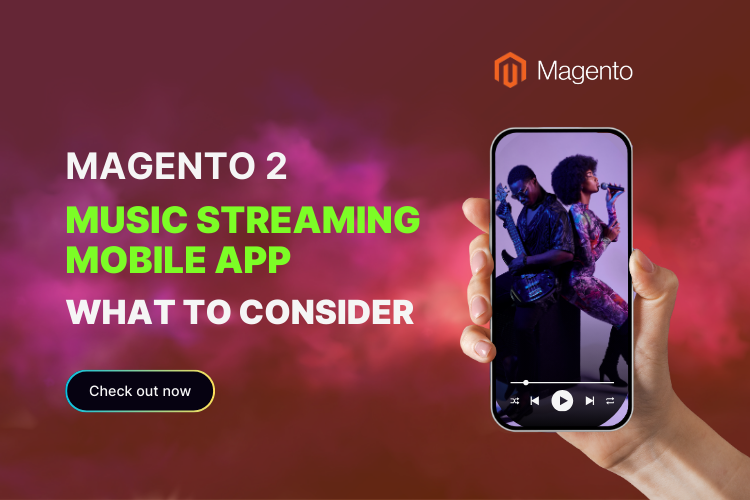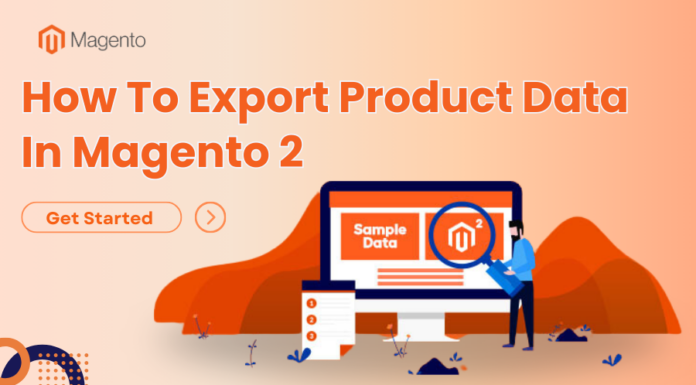
The digital landscape has witnessed a tremendous shift in how people consume music, with mobile apps playing a pivotal role in providing on-the-go access to an extensive library of songs. In this comprehensive guide, we delve into developing a music streaming app with a Magento 2 backend, combining the robustness of e-commerce infrastructure with the dynamic world of digital music.
Table of Contents
What is Magento 2 Music Streaming App Development?
Magento 2 Music Streaming App Development refers to creating a mobile application for streaming music content, with the backend powered by the Magento 2 e-commerce platform. This combination allows for integrating e-commerce functionalities, user management, and payment processing from Magento 2 with the rich media experience of a music streaming app.
I. Why Should You Create a Magento 2 Music Streaming App?
Creating a Magento-based music streaming app can offer several advantages, combining the robust e-commerce capabilities of Magento with the dynamic features required for a music streaming service. Let’s explore statistics highlighting the importance and potential benefits of developing a Magento music streaming app.
1. E-Commerce Market Growth
According to eMarketer, global e-commerce sales were projected to reach $4.2 trillion in 2020 and are expected to continue growing. Integrating a music streaming app with Magento allows you to tap into this thriving market.
2. Magento’s E-Commerce Dominance
As of 2023, Magento powered over 239,000 live websites globally. Magento handles more than $155 billion in gross merchandise every year. Leveraging Magento for your music streaming app ensures a robust and scalable e-commerce infrastructure.
3. Mobile App Usage Trends
The average American spent over 4 hours per day on their mobile devices in 2021, according to eMarketer. Developing a mobile app ensures that you reach users where they spend a portion of their digital time.
4. Music Streaming Industry Growth

The music streaming market was valued at around 34.53 billion in 2022, with a projected growth of $45.9 billion by 2027. The streaming market globally is projected to grow at a CAGR of 14% between 2023 & 2030. Hence, developing a music streaming app aligns with the booming growth of this industry.
5. User Preference for Mobile Music Consumption
A Nielsen Music study in 2020 found that 55% of consumers in the U.S. listened to music through streaming services, surpassing traditional radio. Creating a mobile app caters to the growing preference for on-the-go music consumption.
6. User Engagement through Personalization

Approximately 71% of Spotify’s Discover Weekly users rely on the service’s recommendations. Integrating personalized features in your music streaming app enhances user engagement and satisfaction.
7. Global App Revenue
In 2020, the Apple App Store generated approximately $72.3 billion in consumer spending on in-app purchases and premium apps, while the Google Play Store generated $38.6 billion. Developing a paid subscription model within your app can contribute to this revenue stream.
8. Cross-Platform Development Framework Adoption
React Native, a popular cross-platform development framework, was used by over 42% of mobile developers in 2021, according to the Stack Overflow Developer Survey. Choosing a framework like React Native ensures efficient development for both iOS and Android platforms.
9. Increased Mobile App Revenue
Statista projected that global mobile app revenue would reach $935 billion in 2023. Creating a music streaming app allows you to tap into this lucrative revenue stream.
10. User Loyalty through Mobile Apps
According to Adobe, mobile app users are three times more loyal than website users. Developing a dedicated app can foster customer loyalty and retention.
The combination of Magento’s e-commerce prowess and the growing trends in mobile app usage and music streaming positions a Magento music streaming app as a strategic business move.
II. What to Consider While Developing a Magento 2 Music Streaming App?

Many learn about Magento 2 development to develop music streaming apps but don’t understand the basis for building streaming platforms using this advanced technology. Developing a Magento 2 music streaming app requires a comprehensive and strategic approach, considering various essential factors to create a successful and engaging platform in the highly competitive music streaming industry.
1. Define Your Objectives
Setting clear objectives is paramount for your music streaming app’s success. With the global music streaming market projected to reach $29.8 billion by 2025, defining your target audience, features, and unique selling points is crucial. For instance, the success of Spotify lies in its goal of providing on-demand access to an extensive music library catering to diverse user preferences.
2. Licensing and Copyrights
Obtaining the necessary licenses & ensuring compliance with copyright laws is imperative to avoid legal complications. In 2021, streaming services paid artists and labels over $7.1 billion in royalties. With its artist-owned model, Tidal is an example of a platform that emphasizes fair compensation to artists while offering high-fidelity audio.
3. User Experience (UX) and User Interface (UI)
Crafting an intuitive and visually appealing interface contributes significantly to user engagement. Studies show that 38% of users will only engage with a site if the content and layout are attractive. Apple Music’s success is partly attributed to its clean interface and seamless user experience, particularly among iOS users.
4. Search and Discovery
Robust search and discovery features are essential for users to find and explore music easily. With 75% of users relying on music streaming platforms for music discovery, platforms like Pandora leverage advanced recommendation engines, such as the Music Genome Project, to provide personalized playlists based on user preferences.
5. Payment Integration
Integrating secure and user-friendly payment gateways is crucial for monetizing the app. In 2020, global digital music revenue amounted to $20.7 billion. Spotify’s success in generating revenue is evident through its premium subscriptions, offering users an ad-free experience.
6. Streaming Quality
Optimizing streaming quality is critical to user satisfaction. Spotify, for example, defines 320 kbps as high-quality audio streaming. Meanwhile, Deezer caters to audiophiles by offering lossless FLAC streaming for superior sound quality.
7. Offline Access

Providing offline access allows users to download and listen to music without an internet connection. About 57% of global internet users have downloaded music for offline listening (Statista). Amazon Music, for instance, enables users to download songs, catering to those with limited connectivity.
8. Multi-Platform Compatibility
Ensuring compatibility across various devices is essential. Mobile devices contribute to 60% of global digital music revenue. YouTube Music, for example, ensures a consistent experience across smartphones, tablets, and smart TVs.
9. Performance Optimization
Optimizing performance is crucial for user satisfaction and retention. Slow-loading websites can lead to a 7% loss in customer conversions. SoundCloud addresses this by optimizing performance through edge servers and content delivery networks (CDNs).
10. Social Integration
Integrating social media platforms enhances user engagement. Approximately 51% of users discover new music through social media. Spotify’s integration with Facebook allows users to share playlists & see what their friends are listening to.
11. Analytics and Reporting
Leveraging analytics to track user behavior and preferences is vital for app improvement. A staggering 86% of executives believe data is crucial to decision-making. Apple Music uses analytics to refine recommendations and curate playlists based on user behavior.
12. Security Measures
Implementing robust security measures is paramount to protect user data. Cybersecurity breaches cost the music industry an estimated $5.2 billion annually. Tidal, for example, employs encryption and two-factor authentication to safeguard user information.
13. Scalability
Designing the app architecture with scalability in mind is critical to accommodate a growing user base. With global music streaming subscribers expected to reach 743 million by 2023, platforms like Spotify have scalable infrastructures that handle millions of simultaneous streams during peak times.
14. Compliance and Regulations
Adhering to data protection laws & regulations is imperative. GDPR compliance fines reached €272 million in 2020. A music streaming app like Spotify prioritizes compliance with data protection laws to build trust with users regarding their privacy.
15. Testing
Thorough testing, including functionality, security, and performance, is essential before launching the app. Approximately 88% of users are less likely to return to a site after a bad experience. YouTube Music, for instance, underwent extensive beta testing to address issues and enhance overall performance before launch.
16. Documentation and Support
Providing comprehensive documentation and support channels is crucial for user satisfaction. Most users (73%) prefer self-service options for solving issues. Spotify’s help center and community forums empower users to find solutions independently.
III. How to Create a Music Streaming App with Magento 2 Backend?

Creating a music streaming app with a Magento 2 backend involves integrating the e-commerce capabilities of Magento with the functionality required for streaming audio content. Here’s a step-by-step guide to help you get started:
Step 1: Define Requirements and Features
Identify the core features you want in your music streaming app, ensuring robust functionality such as user authentication, playlist creation, search functionality, offline access, and seamless payment integration. Additionally, optimize the user experience with a Free Shopify Theme to enhance your online store’s visual appeal and navigation.
Step 2: Set Up a Magento 2 Store
Install Magento 2 on your server or utilize a hosting provider, then configure your store, set up products (such as music tracks or subscriptions), and manage user accounts.
Step 3: Choose a Streaming Solution
Decide whether to leverage an existing music streaming API such as Spotify, Apple Music, or Deezer or opt for white-label music streaming software developed to cater to all your business requirements. Alternatively, you can build a custom streaming server based on your requirements.
Step 4: Magento 2 Backend Integration
Develop custom modules or extensions to integrate your chosen streaming solution with Magento 2 seamlessly. This involves creating product types tailored for music tracks or subscription plans. Implement robust user authentication to ensure seamless integration between Magento 2 and the streaming server.
Create a custom module in Magento to handle the integration with the chosen music streaming API. For this example, we’ll use a simple PHP-based API:
// app/code/Vendor/MusicStreaming/Model/Api.php
namespace Vendor\MusicStreaming\Model;
class Api
{
public function getTrack($trackId)
{
// Use API calls to fetch track details from the streaming service
// Return the track information in a structured format
}
}
Step 5: User Authentication
Utilize Magento 2 customer accounts for user authentication and enhance security by implementing OAuth or other secure authentication methods with the streaming server. You can leverage Magento’s built-in customer authentication for user login, ensuring a seamless and secure authentication process.
For Example:
// app/code/Vendor/MusicStreaming/Controller/Login.php
namespace Vendor\MusicStreaming\Controller;
use Magento\Framework\App\Action\Action;
use Magento\Framework\App\Action\Context;
use Magento\Customer\Model\Session;
class Login extends Action
{
protected $customerSession;
public function __construct(Context $context, Session $customerSession)
{
parent::__construct($context);
$this->customerSession = $customerSession;
}
public function execute()
{
// Implement authentication logic with the streaming service
// Set customer session if authentication is successful
}
}Step 6: Music Catalog Management
Create a comprehensive system within Magento 2 to manage your music catalog effectively. Enable easy categorization of music tracks by genres, artists, and albums, ensuring your customers a well-organized and user-friendly browsing experience.
For Example:
// app/code/Vendor/MusicStreaming/Block/Catalog.php
namespace Vendor\MusicStreaming\Block;
use Magento\Catalog\Block\Product\AbstractProduct;
class Catalog extends AbstractProduct
{
public function getMusicTracks()
{
// Fetch and return music tracks from the Magento product catalog
}
}Step 7: Search and Discovery
Implement a robust search functionality within the app to enable users to find their desired music easily. Improve the user experience by integrating features like personalized recommendations and the ability to create customized playlists, ensuring a more engaging and tailored music discovery process for your users.
Step 8: Offline Access
Develop a mechanism within the app that allows users to download tracks for offline listening, allowing them to enjoy their favorite music without requiring an internet connection. In parallel, implement robust security measures to safeguard downloaded content, ensuring the protection of user data and maintaining the integrity of the offline access feature.
For Example:
/ app/code/Vendor/MusicStreaming/Controller/Download.php
namespace Vendor\MusicStreaming\Controller;
use Magento\Framework\App\Action\Action;
use Magento\Framework\App\Action\Context;
class Download extends Action
{
public function execute()
{
// Implement logic for allowing users to download tracks for offline listening
// Use Magento's file-handling capabilities
}
}Step 9: Payment Integration
Integrate secure payment gateways seamlessly into your music streaming app to facilitate smooth transactions for premium subscriptions or one-time purchases. Prioritize compliance with PCI-DSS standards to ensure the secure handling of payment information, providing users with a safe and trustworthy payment experience within the app.
For Example:
// app/code/Vendor/MusicStreaming/Model/Payment.php
namespace Vendor\MusicStreaming\Model;
use Magento\Payment\Model\Method\AbstractMethod;
class Payment extends AbstractMethod
{
// Implement payment gateway integration logic
}Step 10: User Interface and Experience
Design an intuitive and visually appealing UI (user interface) for your music streaming app to enhance user engagement.
Optimize the app to ensure a seamless experience across different devices & screen sizes, catering to diverse user preferences. This approach will contribute to a user-friendly and visually consistent interface, fostering a positive and enjoyable interaction with your app.
Step 11: Testing
Conduct comprehensive testing for your music streaming app, encompassing functionality, security, and performance assessments. Identify any issues during the testing phase and promptly address and rectify them. This iterative testing and refinement process will ensure the app’s robustness, security, and optimal performance before its official launch, contributing to a positive user experience and minimizing post-launch complications.
Step 12: Launch and Marketing
Deploy your music streaming app to major app stores, including iOS and Android, to make it accessible to a broad audience. Simultaneously, implement effective marketing strategies to promote your app and attract users.
Utilize a mix of online & offline channels, social media platforms, influencers, and promotions to create awareness and drive downloads. A well-executed marketing approach can significantly contribute to the success and visibility of your music-streaming app in the competitive app marketplace.
Step 13: Analytics and Improvements
Integrate analytics tools into your music streaming app to track user behavior, identify popular tracks, and measure engagement metrics.
Utilize the gathered data to make informed decisions and implement improvements to improve the overall user experience. This iterative approach, based on data-driven insights, will enable you to refine features, optimize content delivery, and stay responsive to evolving user preferences, fostering your app’s long-term success and growth.
Step 14: Maintenance and Updates
Ensure the ongoing success of your music streaming app by committing to regular updates. This includes incorporating new features, addressing bug fixes, and implementing necessary security patches. Actively monitor user feedback to identify areas for improvement and prioritize user suggestions.
By maintaining a proactive approach to updates and attentively addressing user feedback, you can cultivate a responsive and evolving app that meets user expectations and stands out in the competitive landscape. Regular updates contribute to user satisfaction and long-term app success.
Additional Tips
Consider the legal aspects of your music streaming app, ensuring adherence to proper licensing and compliance with copyright laws. This is essential to avoid legal complications and establish a trustworthy and ethical platform.
Additionally, stay well-informed about industry trends and emerging technologies to keep your app competitive in the dynamic music streaming landscape. Being proactive in legal matters and staying abreast of industry developments will contribute to your app’s long-term success and sustainability in a constantly evolving market.
Example Technologies
Magento 2: E-commerce backend
Streaming API: Spotify, Deezer, or custom streaming server
Mobile App Development: Swift (iOS), Kotlin (Android), or cross-platform frameworks like React Native or Flutter
Ending Note
A Magento 2 music streaming app’s development and success requires a meticulous approach encompassing various aspects, from technical considerations to legal compliance and user experience. By addressing factors such as robust backend integration, intuitive user interfaces, security measures, and ongoing improvements based on analytics, you can create a compelling and competitive music streaming app.
Stay vigilant about legal requirements, user feedback, and industry trends to ensure the app’s relevance and longevity. With a thoughtful and strategic approach, your Magento 2 music streaming app can offer an engaging experience to users while meeting industry standards and legal obligations.
Author Bio
| Dilshad Durani is a seasoned Digital Marketer and Content Creator currently contributing her expertise to the dynamic team at Alphanso Technology, a leading company specializing in music and live-streaming software development. She is curious to learn new things and is passionate about helping people understand market trends, changing marketing approaches, business ethics, and more with her writing. |












![[SALE OFF] Discount 30% All Premium Extensions On Christmas And New Year 2025 christmas-and-new-year-2025](https://landofcoder.b-cdn.net/wp-content/uploads/2024/12/christmas-and-new-year-2025-1-218x150.png)






